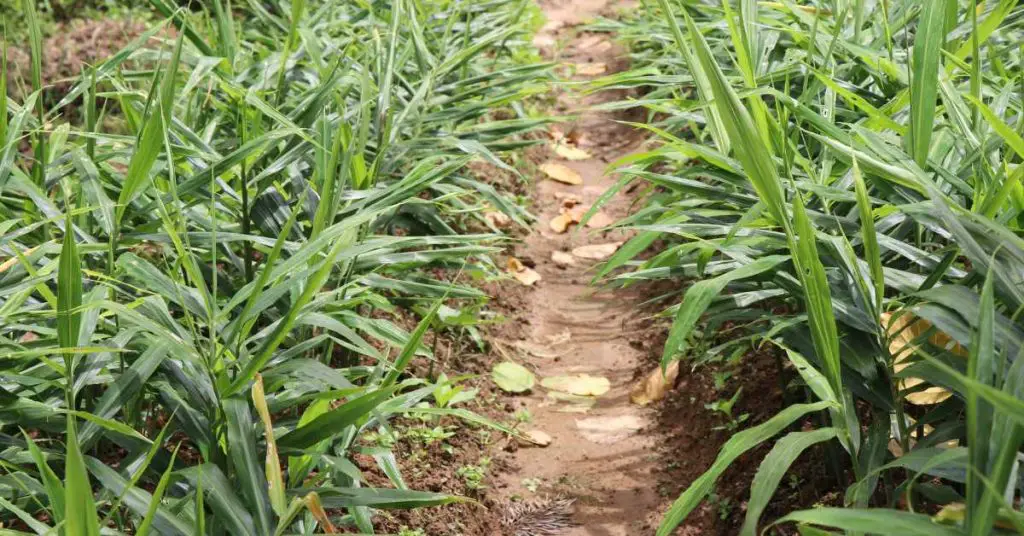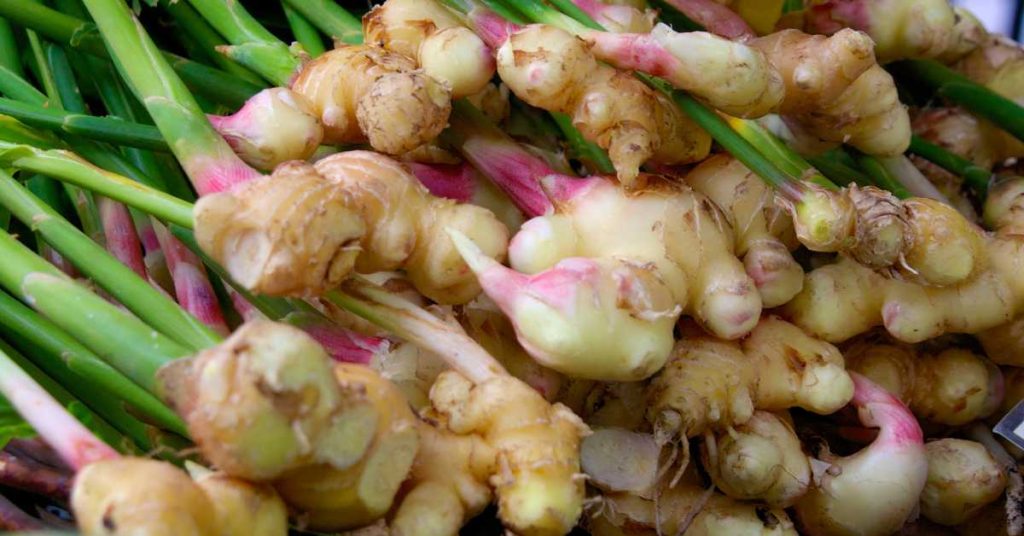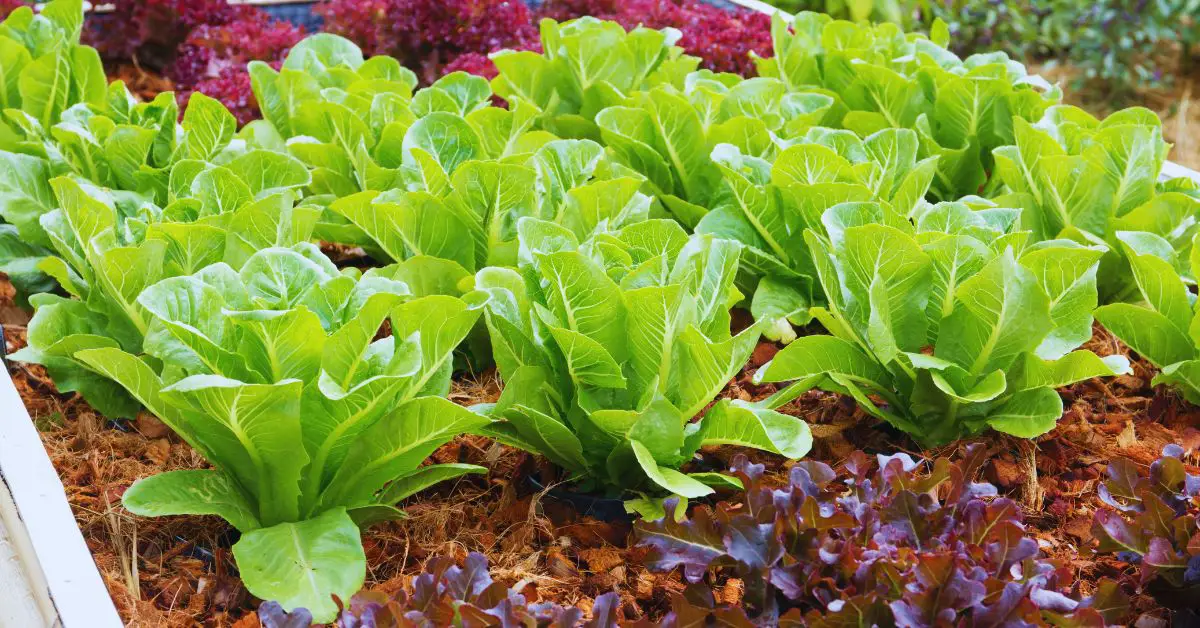Are Ginger Leaves Edible? Yes, Ginger leaves are edible. They have a more subtle ginger flavor which makes them a great choice when you just want a hint of flavor. However, Ginger leaves can be a bit fibrous.
In this article, we’ll explore the edibility of ginger leaves and their potential culinary uses. By understanding whether ginger leaves are safe to eat and how to prepare them, you can add a new dimension to your culinary repertoire.
Key Takeaways
- Ginger leaves are edible and can be used in various recipes.
- Ginger leaves are rich in essential vitamins and minerals.
- Ginger leaves have medicinal properties, including anti-inflammatory and antioxidant benefits.
- Ginger leaves can be used in culinary dishes, herbal remedies, and as natural food wrappers.
Are Ginger Leaves Edible?
Ginger leaves are indeed edible, but they can be fibrous, so you may want to consider cooking or processing them before consuming. Although ginger roots are more commonly used in cooking and medicinal purposes, ginger leaves also possess their own unique benefits.
These leaves can be used in various ginger leaf recipes such as ginger leaf salad or ginger leaf soup. Not only do ginger leaves add a subtle, peppery flavor to dishes, but they also contain medicinal properties. They’re rich in antioxidants, anti-inflammatory compounds, and vitamins, making them a valuable addition to your diet.
Additionally, ginger leaves can have alternative uses, such as being used as a natural insect repellent or as a fragrant addition to potpourri.

Edibility of Ginger Leaves
You can eat ginger leaves, but they may be fibrous. Despite their fibrous texture, ginger leaves can be used in various ways.
Here are some ideas to make the most of ginger leaves:
- Cooking methods: Ginger leaves can be used in stir-fries, soups, and curries. They add a unique flavor and aroma to dishes.
- Medicinal properties: Ginger leaves contain compounds that have anti-inflammatory and antioxidant properties. Consuming ginger leaves can contribute to overall well-being.
- Ginger leaf recipes: Try making ginger leaf tea by steeping the leaves in hot water. You can also use them as a wrap for steaming fish or vegetables, infusing the food with a subtle ginger flavor.
- Alternative uses: Ginger leaves can be used as a natural insect repellent. Simply crush the leaves and rub them on your skin to ward off mosquitoes.
Remember to store ginger leaves in the refrigerator, wrapped in a damp paper towel to maintain their freshness.
Nutritional Value of Ginger Leaves
The nutritional value of ginger leaves is worth exploring for their potential health benefits.
Ginger leaves have a rich nutritional profile, containing essential vitamins such as vitamin C, vitamin A, and vitamin K. They also provide minerals like potassium, calcium, and iron.
These leaves can be incorporated into various cooking methods, such as stir-frying, steaming, or adding them as a garnish in soups and salads. Ginger leaf recipes are popular in many culinary traditions, adding a unique flavor and aroma to dishes.
Apart from their culinary uses, ginger leaves are known for their medicinal properties. They’ve been used in traditional medicine for their anti-inflammatory, antioxidant, and digestive benefits.
Including ginger leaves in your diet can be a nutritious and flavorful addition to your meals, offering both taste and potential health benefits.
Culinary Uses of Ginger Leaves
Exploring the culinary potential of ginger leaves can enhance your cooking experience and add a unique flavor to your dishes. Ginger leaves aren’t only edible but also possess various medicinal properties and cultural significance.
Here are some culinary uses, alternative uses, and foraging tips related to ginger leaves:
- Culinary Recipes: Ginger leaves can be used as a flavorful ingredient in various dishes such as stir-fries, curries, soups, and teas. They impart a subtle ginger flavor and aroma, enhancing the overall taste of the dish.
- Medicinal Properties: Ginger leaves are known for their medicinal properties, including anti-inflammatory and digestive benefits. They can be used in herbal remedies, infusions, or poultices to alleviate symptoms of nausea, indigestion, or inflammation.
- Cultural Significance: In many cultures, ginger leaves are used in traditional recipes and rituals. They symbolize prosperity, good luck, and healing.
- Alternative Uses: Ginger leaves can be used as natural food wrappers for steaming or grilling fish or vegetables, imparting a delicate ginger flavor. They can also be infused into oils or vinegars for added flavor in dressings or marinades.
Foraging Tips: When foraging for ginger leaves, look for young, tender leaves that are bright green in color. Avoid leaves that are wilted or discolored. Harvest the leaves carefully, using a sharp knife or scissors, and ensure that you leave enough leaves on the plant for continued growth.
Incorporating ginger leaves into your culinary repertoire can’t only expand your flavor profile but also provide you with the added benefits of their medicinal properties. Be sure to explore different recipes and techniques to fully appreciate the unique flavor and cultural significance of ginger leaves.
Health Benefits of Consuming Ginger Leaves
Incorporating ginger leaves into your diet can provide you with numerous health benefits due to their medicinal properties and nutritional value.
Ginger leaves possess a range of medicinal properties that can promote overall well-being. Firstly, they’re known to support digestive health by aiding in digestion, reducing bloating, and relieving nausea and stomach discomfort.
Additionally, ginger leaves are packed with antioxidants and vitamins that can boost your immune system, helping to protect against infections and diseases.
Furthermore, these leaves exhibit anti-inflammatory effects, which can help reduce inflammation in the body and alleviate symptoms of chronic conditions such as arthritis.
Lastly, ginger leaves can contribute to weight management by increasing metabolism and promoting fat burning.
How to Prepare and Cook Ginger Leaves
To prepare and cook ginger leaves, you can easily incorporate them into your favorite recipes.
Here are some ideas to explore the flavor profiles, traditions, remedies, and sustainability of using ginger leaves in your cooking:
- Flavor profiles: Ginger leaves have a unique, peppery taste with hints of citrus and earthiness. Experiment with different combinations, such as pairing them with garlic and soy sauce for a savory stir-fry or infusing them in a refreshing ginger and mint tea.
- Creative recipes: Get innovative by incorporating ginger leaves into dishes like ginger leaf pesto, where you can replace traditional basil with these flavorful leaves. You can also add them to salads, soups, and even sushi rolls for an unexpected twist.
- Culinary traditions: In various cuisines, ginger leaves are widely used. For example, in Thai cuisine, they’re often used in curries and soups to add depth of flavor. In Indian cuisine, ginger leaves are used to wrap and steam fish or chicken, infusing them with aromatic flavors.
- Herbal remedies: Ginger leaves have long been recognized for their medicinal properties. They’re known to aid digestion, reduce inflammation, and boost the immune system. Explore traditional remedies like ginger leaf tea or incorporate them into herbal infusions for their healing benefits.
- Sustainability: Using ginger leaves in cooking can contribute to sustainability efforts. By utilizing all parts of the ginger plant, including the leaves, we reduce waste and maximize the plant’s potential. Additionally, growing ginger at home allows for a more sustainable approach, reducing transportation emissions and promoting self-sufficiency.
Incorporating ginger leaves into your cooking not only adds unique flavors but also connects you to culinary traditions, offers potential health benefits, and promotes sustainability. So, go ahead and get creative with ginger leaves in your kitchen!

Potential Risks and Precautions of Consuming Ginger Leaves
Consuming ginger leaves carries potential risks and precautions that you should be aware of. While ginger leaves are generally safe to eat, it’s important to note that some individuals may experience potential side effects or allergic reactions. It’s recommended to start with a small amount and monitor your body’s response. If you experience any adverse reactions such as stomach upset, rashes, or difficulty breathing, discontinue use immediately and seek medical attention.
Additionally, it’s crucial to use ginger leaves in moderation and follow the proper dosage guidelines. Excessive consumption may lead to digestive issues or interact with certain medications. When cooking ginger leaves, ensure they’re thoroughly washed to remove any dirt or pesticides.
It’s also important to note that ginger leaves can be used for alternative purposes, such as making tea or as a natural remedy for various ailments. Always consult with a healthcare professional before incorporating ginger leaves into your diet to ensure it’s safe for your individual needs.
Ginger Leaf Tea: a Soothing Beverage Option
For a soothing beverage option, consider brewing ginger leaf tea. Ginger leaves can be used in a variety of ways, including making refreshing and nourishing beverages.
Here are some ideas to incorporate ginger leaves into your drinks:
- Ginger Leaf Smoothies: Blend ginger leaves with your favorite fruits and vegetables for a nutritious and flavorful smoothie.
- Ginger Leaf Infused Water: Add ginger leaves to a pitcher of water and let it infuse for a refreshing and lightly flavored drink.
Ginger leaf tea offers a soothing and comforting option for those seeking relaxation. Moreover, ginger leaves are known for their potential health benefits, including aiding digestion and reducing inflammation. So why not try brewing a cup of ginger leaf tea and enjoy its soothing effects?
How To Incorporate Ginger Leaves Into Your Diet
If you’re looking to incorporate ginger leaves into your diet, now is the time to explore the various ways you can enjoy their unique flavors and potential health benefits.
One way to incorporate ginger leaves is by adding them to your smoothies. Simply blend the leaves with your favorite fruits and vegetables for an added kick of flavor and nutrition.
Another option is to use ginger leaves in salads. Chop them up and toss them with your greens for a refreshing and aromatic twist.
If you’re feeling adventurous, you can even create ginger leaf infused oils or seasoning blends. These can be used to add a hint of ginger flavor to your dishes.
Lastly, consider making ginger leaf pesto. Blend the leaves with garlic, nuts, and olive oil for a delicious and versatile sauce.
With these options, you can easily incorporate ginger leaves into your diet and enjoy their unique taste and potential health benefits.
Frequently Asked Questions
Are Ginger Leaves Safe to Eat Raw?
Yes, ginger leaves are safe to eat raw. They have nutritional value, culinary uses, and health benefits. You can incorporate them in your diet by adding them to salads or smoothies. Store them in the refrigerator to preserve freshness.
Can Ginger Leaves Be Used as a Substitute for Ginger Root in Recipes?
Ginger leaves can be used as a substitute for ginger root in recipes. They have culinary uses such as adding flavor to dishes and can be used in various culinary techniques. They have a similar flavor profile to ginger root and can be preserved for future use.
Can Ginger Leaves Be Dried and Used as a Spice?
Yes, ginger leaves can be dried and used as a spice. They have culinary uses in various cultures and provide health benefits due to their nutritional value. To preserve them, dry and store in an airtight container.
Are Ginger Leaves Commonly Used in Traditional Medicine?
Yes, ginger leaves have health benefits and can be used in various culinary dishes. They can also be prepared by drying or steeping in teas. Additionally, ginger leaves have medicinal properties and are commonly used in traditional remedies.
Do Ginger Leaves Have a Strong Flavor?
Ginger leaves can be used to make tea, add flavor to dishes, and have health benefits. Harvest ginger leaves when young and tender, and preserve them by drying or freezing. They do have a strong flavor.
Conclusion
In conclusion, ginger leaves are indeed edible and offer a range of culinary uses and health benefits. These leaves are rich in antioxidants, vitamins, and minerals, making them a nutritious addition to your diet.
They can be used in various dishes, including stir-fries, salads, and teas. However, it’s important to note that some individuals may experience allergies or digestive issues, so it’s advisable to consume ginger leaves in moderation and consult a healthcare professional if needed.
Incorporating ginger leaves into your meals can enhance flavors and promote overall well-being.





